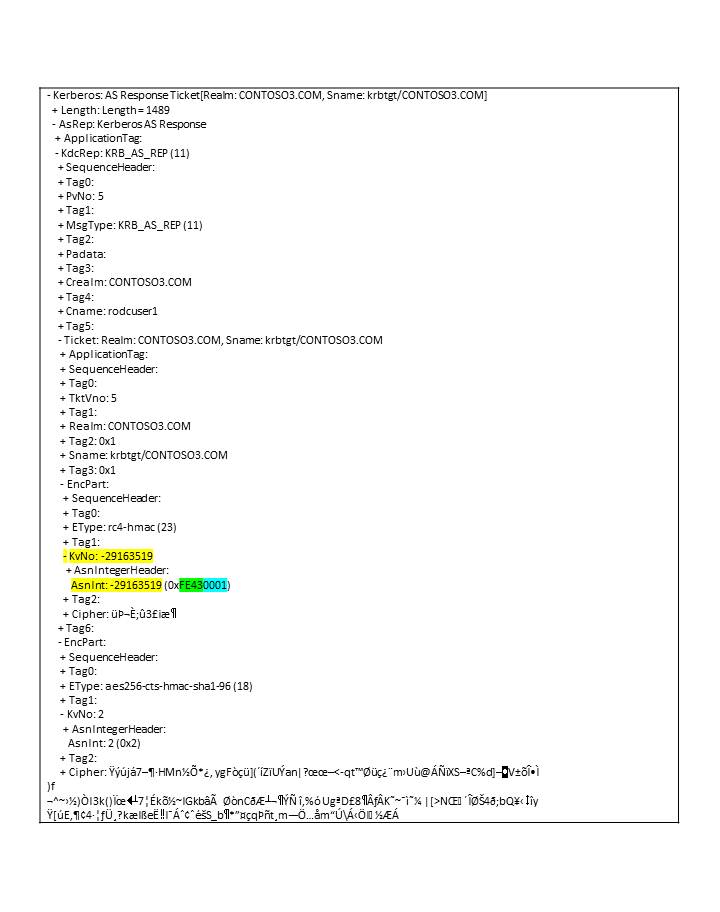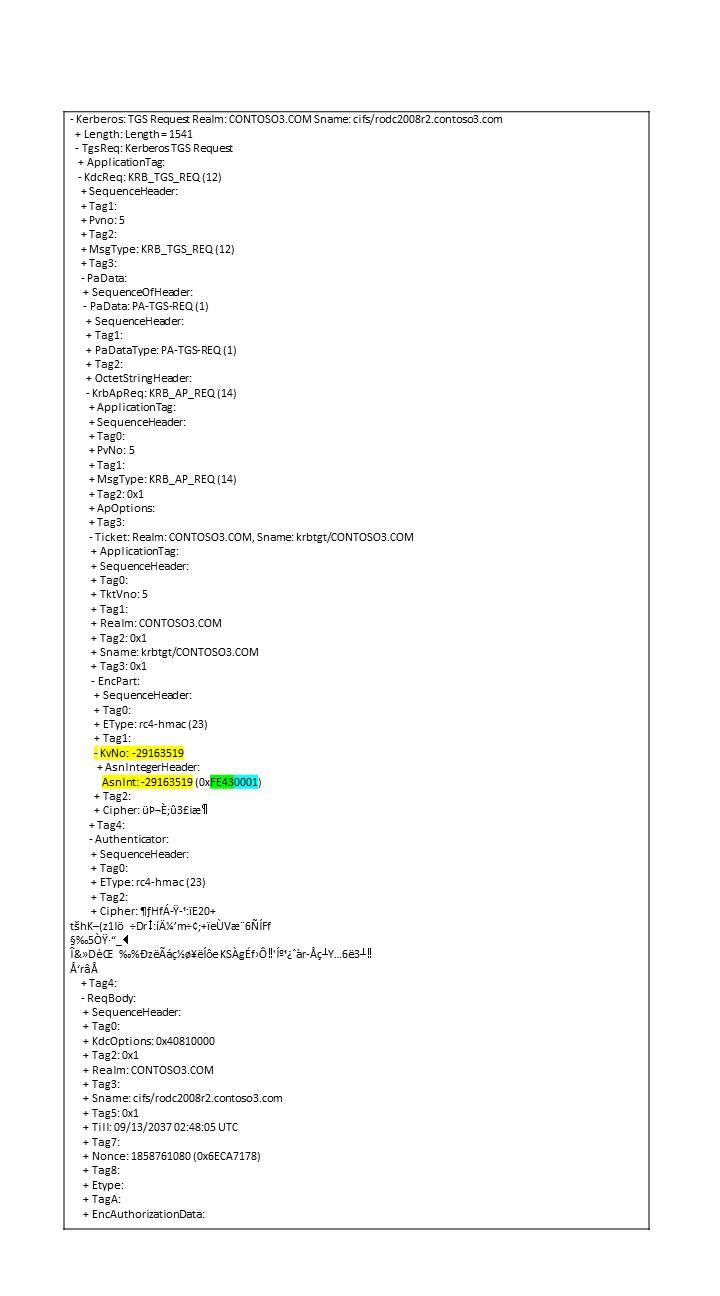Notes on Kerberos kvno in Windows RODC environment
This blog talks about key version number (kvno) in a read-only domain controller (RODC) environment. A previous blog introduced kvno in general. Here, I look at specifics in RODC environment.
For a refresher, the kvno is a field of the EncryptedData structure (RFC4120 Section 5.2.9). It indicates the version number of the key used to encrypt data. When a Kerberos peer needs to decrypt an EncryptedData structure from a message, it must use the exact version of the key that was used to encrypt the message.
EncryptedData ::= SEQUENCE {
etype [0] Int32 -- EncryptionType --,
kvno [1] UInt32 OPTIONAL,
cipher [2] OCTET STRING -- ciphertext
}
RFC4120 describes the kvno as follows.
Key Version Number (kvno)
A tag associated with encrypted data identifies which key was used
for encryption when a long-lived key associated with a principal
changes over time. It is used during the transition to a new key
so that the party decrypting a message can tell whether the data
was encrypted with the old or the new key.
An RODC is a new type of domain controller introduced in Windows Server 2008. An RODC hosts read-only partitions of the Active Directory Domain Services (AD DS) database. An RODC is typically deployed in a branch office. The RODC is advertised as a Key Distribution Center (KDC) for the branch office.
Cryptographic isolation is achieved between RODC KDCs in branch offices by using a special type of krbtgt accounts. That is, an RODC uses a different krbtgt account and password than the KDC on a writable domain controller uses when it signs or encrypts ticket-granting ticket (TGT) requests. When an RODC recognizes that another DC signs the TGT, it forwards related requests to the writeable DC.
Each RODC KDC has a special krbtgt account in form of krbtgt_<RodcID>. The RodcId identifies the RODC and is generated when the RODC is installed. Its value is stored in the msDS-SecondaryKrbTgtNumber attribute (see example below, the attribute is documented in MS-ADA2).
The RodcID value is randomly chosen by the system between 1 and 0xFFFF, but is unique across the domain, as specified in MS-ADTS 3.1.1.3.4.1.23 LDAP_SERVER_RODC_DCPROMO_OID. Only SYSTEM has the write privilege on the msDS-SecondaryKrbTgtNumber attribute; this is a system only attribute, and is not meant to be modified.
Like in any writeable DC, the RODC krbtgt_<RodcID> account is under the CN=Users,DC=contoso3,DC=com container. Its cn, name and sAMAccountName are krbtgt_<RodcID>. Unlike a regular krbtgt account, this account does not have servicePrincipalName: kadmin/changepw. The kadmin/changepw service is not needed on an RODC since it enables changing a principal’s password via Kerberos ([RFC3244]). An example of the LDAP record of a RODC krbtgt account is provided at the end of this blog.
Windows RODC implementation generates kvnos as defined in MS-KILE 3.1.5.8. When a TGT is issued by an RODC, the first 16 bits of the kvno, including the most significant bit, are an unsigned 16-bit and identify the RODC instance. The remaining 16 bits are the version number of the key (typically the version number is incremented by one when the password changes).
In an example where the RodcID is 65091 (i.e. 0xFE43), and the key version is 1, the encoding is shown on the wire as follows: KvNo: A1 06 02 04 FE 43 00 01.
In the AS response below, the EncPart of TGT ticket is encrypted with the RODC key and has a kvno which identifies the RODC. The EncPart of the KRB_AS_REP is encrypted with the client key and has a regular kvno. The client’s key is derived upon replication from a writable DC and is not tied to the RODC.
When the client sends the TGS-REQ and presents the TGT that was issued by this particular RODC, the RodcID of the kvno (first 16 bits, e.g. 0xFE43) has to match the RodcID of the krbtgt_<RodcID> account. Likewise, the version of the key (remaining 16 bits of the kvno, e.g. 0x0001) has to match a version of the key stored on the RODC.
It should be noted that if the TGS-REQ is malformed, e.g. Kvno encoded with more than 4 bytes, it is possible that the KDC discards the request without an error indication, for the purpose of mitigating a security attack.
In the TGS response, the EncPart of the TGS ticket is encrypted with the server’s long-term key and has a regular Kvno. The server’s long-term key is derived upon replication from a writable DC and is not tied to the RODC.
Example of LDAP record for RODC krbtgt account
-----------
Dn: CN=krbtgt_65091,CN=Users,DC=contoso3,DC=com
accountExpires: 9223372036854775807 (never);
cn: krbtgt_65091;
codePage: 0;
countryCode: 0;
description: Key Distribution Center service account for read-only domain controller;
distinguishedName: CN=krbtgt_65091,CN=Users,DC=contoso3,DC=com;
dSCorePropagationData: 0x0 = ( );
instanceType: 0x0 = ( );
msDS-KrbTgtLinkBl: CN=RODC2008R2,OU=Domain Controllers,DC=contoso3,DC=com;
msDS-RevealedDSAs (5): CN=RODC2008R2,OU=Domain Controllers,DC=contoso3,DC=com; CN=RODC2008R2,OU=Domain Controllers,DC=contoso3,DC=com; CN=RODC2008R2,OU=Domain Controllers,DC=contoso3,DC=com; CN=RODC2008R2,OU=Domain Controllers,DC=contoso3,DC=com; CN=RODC2008R2,OU=Domain Controllers,DC=contoso3,DC=com;
msDS-SecondaryKrbTgtNumber: 65091;
name: krbtgt_65091;
objectCategory: CN=Person,CN=Schema,CN=Configuration,DC=contoso3,DC=com;
objectClass (4): top; person; organizationalPerson; user;
objectGUID: e202b0df-f929-4ace-8629-78783658db7b;
objectSid: S-1-5-21-2500985174-1773465433-1062056707-1113;
primaryGroupID: 513 = ( GROUP_RID_USERS );
pwdLastSet: 2/1/2011 2:38:05 PM Pacific Standard Time;
sAMAccountName: krbtgt_65091;
sAMAccountType: 805306368 = ( NORMAL_USER_ACCOUNT );
showInAdvancedViewOnly: TRUE;
userAccountControl: 0x202 = ( ACCOUNTDISABLE | NORMAL_ACCOUNT );
uSNChanged: 7740;
uSNCreated: 7740;
whenChanged: 2/1/2011 2:38:50 PM Pacific Standard Time;
whenCreated: 2/1/2011 2:38:05 PM Pacific Standard Time;
-----------
[References]
1. RFC 4120 https://www.ietf.org/rfc/rfc4120.txt
2. [MS-KILE] https://msdn.microsoft.com/en-us/library/cc233855(PROT.13).aspx
3. AD DS: Read-Only Domain Controllers https://technet.microsoft.com/en-us/library/cc732801(WS.10).aspx


